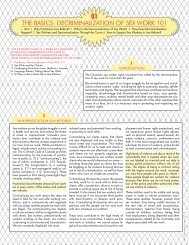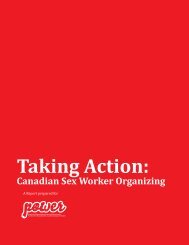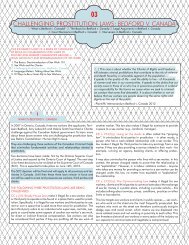3LIMITS TO <strong>THE</strong> CANADIAN <strong>CHARTER</strong>OF RIGHTS <strong>AND</strong> FREEDOMSAll laws and government practices in Canada must be compatible withthe Constitution, which includes the Charter. However, the governmentand the courts still have the power to uphold a law that violates a Charterright by using Section 1 of the Charter:Section 1 of the Charter: “The Canadian Charter of Rights and Freedomsguarantees the rights and freedoms set out in it subject only tosuch reasonable limits prescribed by law as can be demonstrably justifiedin a free and democratic society.”In other words, proving that a certain law or government action violatesa Charter right is not enough to force the government to change it, if thecourt decides that the Charter violation in question is “justified in a freeand democratic society.” So even if the court agrees that a certain lawor government action violates a Charter right, they still have the powerto say that it’s “justified” under s. 1, and therefore not unconstitutional.4CHANGING UNCONSTITUTIONAL LAWAn unconstitutional law can be struck down (meaning it is no longerin force), or changed to make it compatible with the Constitution andCharter. This process can happen in two ways:1. The government can initiate this. The legislators (the people whowrite the laws) can decide to modify the law by passing a Bill. Beforedoing so, the government can ask the Court for their opinion on thelaw’s constitutionality - this is called a “Reference”. Here’s an example:In 1990 the Manitoba government questioned whether the bawdyhouselaw and communicating law were unconstitutional (sections 193and 195.1(1)(c) of the Criminal Code at the time). They asked thecourts for their opinion. First, the Manitoba Court of Appeal, and thenthe Supreme Court of Canada (SCC). See the SCC decision at: http://scc.lexum.org/en/1990/1990scr1-1123/1990scr1-1123.htmlSpecifically, the government wanted to know whether these laws violatedthe right to freedom of expression and the right to liberty and securityof the person (rights protected by s. 2(b) and s. 7 of the Charter).The majority of the SCC decided that the bawdy-house law did notviolate s. 2(b) or s. 7 of the Charter. So, in their opinion this law wasnot unconstitutional and need not be changed. On the other hand, themajority decided that the communicating law did violate s. 2(b) of theCharter, but this violation was deemed to be justified under s. 1. So, intheir opinion, it also did not need to be changed.2. People who are not part of the government can also challenge theconstitutionality of a law or government practice by launching a Chaterchallenge.Some Rights and FreedomGuaranteed by the CharterFundamental FreedomsFreedom of conscience; freedomof religion; freedom of thought;freedom of opinion; freedom ofexpression; freedom of association.Democratic RightsRight to participate in politicalactivities; right to democracy; theright to vote and to be eligible forelection.Legal RightsRight to life, liberty and security ofperson; protection againstunreasonable and arbitrarydetention; upon arrest or detention,the right to counsel, the right to beinformed of that right, the right tosilence; rights in criminal and penalmatters, such as the presumption ofinnocence; the right to an intepreter;the right to equality; rightto equal treatment before the lawwithout discrimination (age,gender, race, etc.)Published in April 20132
5Charter CHALLENGESIf an individual’s or group’s protected Charter rights orfreedoms are being violated by a government law orpractice, they can try to initiate a Charter challenge. Thismeans taking the government responsible for the law orpractice to court.The individual or group who launches the Charter challengeis called the plaintiff or applicant. The plaintiff(s)has to demonstrate in court how the law or practice inquestion violates their Charter right(s). At the base ofevery challenge is a specific law(s) or practice that isbeing contested, and a specific Charter right(s) that theplaintiffs say have been violated.Many individuals and groups have challenged laws andgovernment actions under the Charter, including francophonecommunities, religious groups, a doctor whopractices abortion, men opposed to abortion, pilots,swingers, provincial governments, Indigenous people,LGBTQ communities, prisoners, and migrants. Includingthe current Bedford v. Canada case and the SWUAVv. Canada case, there have been three cases involvingsex work and the Charter that have been heard by theSupreme Court of Canada.Here are two examples of how our allied communitieshave launched Charter challenges:In a case called Little Sisters Book and Art Emporium v.Canada (2000), the plaintiffs claimed that a particulargovernment practice was unconstitutional – the way customsofficers treated the erotic material that Little Sistersimported to their store. The plaintiffs claimed that the customsofficials delayed, confiscated, destroyed and misclassifiedmaterials imported by the plaintiff’s bookstoreand treated the material differently than erotic materialimported by other businesses. They argued that this wasdue to the LGBTQ content of their material, and thereforeviolated their right to freedom of expression and freedomfrom discrimination (protected by s. 2(b) and s. 15of the Charter). Little Sisters can be found at: http://scc.lexum.org/en/2000/2000scc69/2000scc69.htmlIn the “Insite case”, the plaintiffs challenged parts ofthe Controlled Drugs and Substances Act that prohibitspossession and trafficking of illegal drugs. They arguedthat these laws violated their right to security ofthe person and liberty (protected by s. 7 of the Charter),by preventing them from operating a supervised injectionsite. The plaintiffs did not demand that the challengedlaws be repealed, but that they should not applyto people in their particular safe injection site. In thiscase, the SCC agreed with the plaintiffs and decidedthat the violations were not justified. The plaintiffs wontheir right to operate a safe injection site. In other words,people using the site can no longer be arrested underthe Controlled Drugs and Substances Act. The case,Canada (Attorney General) v. PHS Community ServicesSociety (2011) can be found at: http://scc.lexum.org/en/2011/2011scc44/2011scc44.html6winning a charter ChallengeWhen a case goes all the way to the Supreme Court ofCanada (SCC), the decision is final. If the SCC decidesthat a certain law is unconstitutional and cannot be justified,judges are required to do whatever it takes to fix theunconstitutional law. Various things can happen:First, they can “strike down” the law – meaning that thelaw is no longer in force and cannot be applied.Second, they can strike down the law but hold off onmaking the law invalid, to give Parliament time to changethe law.Third, the court might “read in” or “read down” a law– meaning they change or reinterpret part of the law sothat it either no longer violates someone’s Charter rights,or reduces the violation to a level that the court finds acceptable.When the courts or Parliament re-write a law, unless theyfully grasp the Charter violation that they are attemptingto repair, the new or changed law could be equally problematicfor the plaintiffs.77Losing a charter ChallengeIf the court rules against the plaintiff and the plaintiff canno longer appeal the decision – either because their appealis rejected or because it’s the SCC’s final decision– the law or practice remains as is (“status quo”).This is damaging for the people and communities whosupported the Charter challenge. Not only does the lawremain in effect but also if the court decides that the contestedlaw or practice is constitutional, it will be very difficultto challenge it again (at least for many years).The court’s decision reinforces the idea that the law orpractice is legitimate. This can have harmful social impactssuch as reinforcing public perspectives that devaluethe plaintiffs and legitimize the discrimination and stigmathat they face.That being said, in exceptional cases Parliament could bepersuaded to modify a law due to public pressure, evenif the SCC had previously decided the law was constitutional.Published in April 20133







